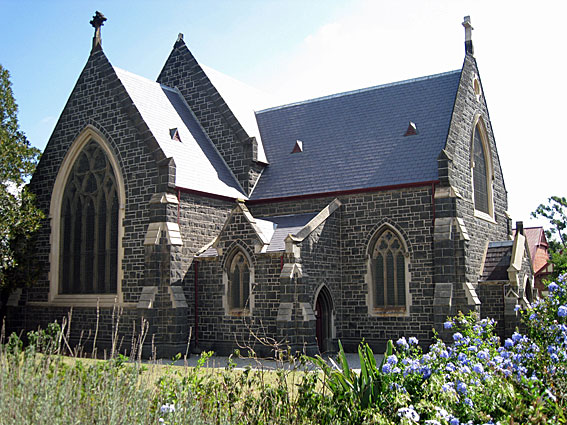
St Mary's Anglican Church, North Melbourne
[Photograph by Geoffrey Cox (March 2017)]

St Mary's Anglican Church, North Melbourne
[Photograph by Geoffrey Cox (March 2017)]
Historical and Technical Documentation by Geoffrey Cox
© OHTA 2017 (last updated September 2017)
The foundation stone of St Mary's Church was laid by the Governor of Victoria, Sir Henry Barkly, on 25 October 1858.1 The nave of the building, complete with clerestory and side aisles, was opened on Sunday 11 March 1860.2 Designed by Melbourne architect Lloyd Tayler in the Later Gothic Rudimentary Decorated style, the building is constructed in bluestone with freestone dressings, and is said to be Tayler's earliest church.13
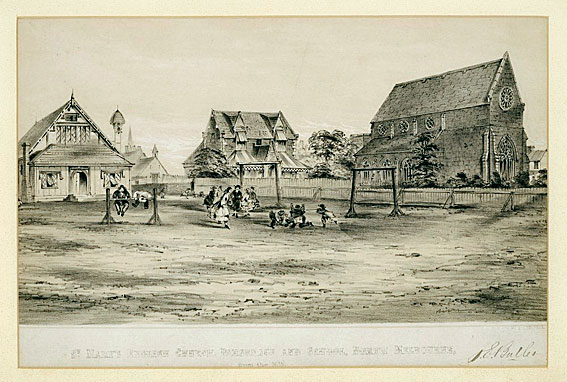
St Mary's English Church, Parsonage and School, North Melbourne
[Lithograph by J.E. Butler (Fergusson & Mitchell, c.1862)
– SLV Accession No H2134]
The transepts and chancel were added in 1868,4 and an organ chamber in 1869.5 The proposed tower and spire, shown in a wood engraving of 1868, were never completed.
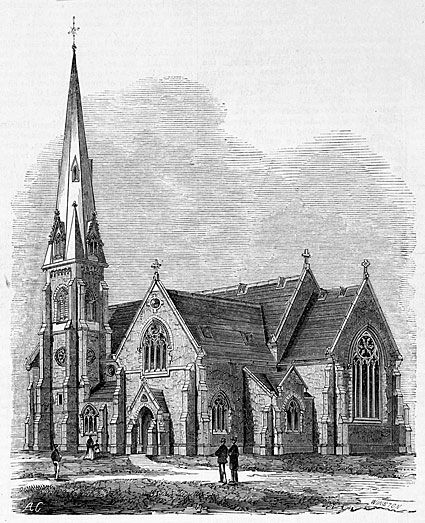
St Mary's Episcopal Church, North Melbourne
[Wood engraving by Winston (1868), published in
The Illustrated Australian News (1 December 1868), p. 4.]
First Organ.
The first organ in St Mary's Church was built by William Anderson of Melbourne. It was opened and dedicated on Friday 12 September 1879, on which occasion the Bishop of Melbourne preached and the music was led by the choir of St Peter's Eastern Hill, conducted by Joseph Summers.6
St. Mary's Church, Hotham, was crowded last night, on the occasion of the dedication of the new organ lately erected. The organ is a fine instrument, built by Mr. W. Anderson, of Melbourne. The choral services were very effectively rendered by Mr. J. Summers and St. Peter's choir. These consisted of the Voluntary, Processional hymn, preces and responses, Magnificat, and Nunc dimittis.7
The organ was just one stop smaller than the two-manual instrument built by Anderson for St Mark's Anglican Church, Fitzroy, two years earlier. The specification was recorded by George Frederick Stephens around May 1930 on the basis of communication from Mr Hammond Hayward (Organist of St Mary's, October 1872 - March 1887):
1. 2. 3. 4. 5. 6. 7. |
GREAT ORGAN Open Diapason Stopped Diapason Bass Clarabella (Ten. C) Bell Gamba (Ten. C) Stopped Flute (Ten. C) Principal Fifteenth |
8ft. 8ft. 8ft. 8ft. 4ft. 4ft. 2ft. |
CC to G 56 NOTES Metal Wood Wood Metal Metal Metal Metal |
8. 9. 10. 11. 12. 13. |
SWELL ORGAN Open Diapason Stopped Diapason Keraulophon (Ten. C) Principal Fifteenth Hautboy (Ten. C) |
8ft. 8ft. 8ft. 4ft. 2ft. 8ft. |
CC to G 56 NOTES Metal Wood Metal Metal Metal Metal |
14. |
PEDAL ORGAN Pedal Pipes |
16ft. |
CCC to F 30 NOTES Open Wood |
15. 16. 17. |
COUPLERS Swell to Great Swell to Pedal Great to Pedal.8 |
An illustration in the Churchwarden's Annual Report for 1879 depicts the interior of the church, including an organ in the organ chamber on the right-hand side of the chancel.9 This presumably represents Anderson's original simple case, which was to be altered some fifteen years later.
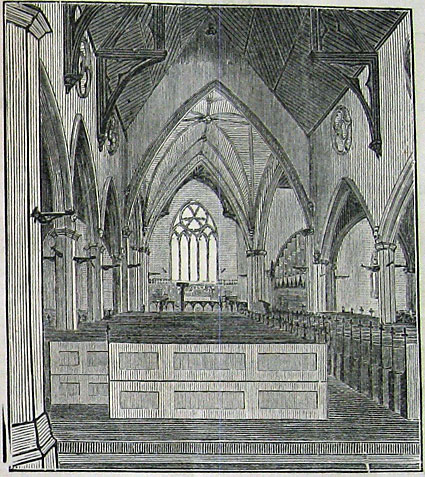
Interior of St Mary's Church, Hotham
[Illustration published in Churchwarden's Annual Report for 1879]
The Churchwarden's Report for 1880 reveals that the Hautboy stop (Tenor C) was not actually added until that year:
Payment of £10 to William Anderson, organ-builder Oboe stop, tenor C to G.10
George Fincham reported on the condition of the organ in 1893 and undertook repairs to the Hautboy stop in 1894.11 He undertook more comprehensive restoration work on the organ in 1910.12
By 1929, extensive additions and improvements to the organ were envisaged. George Fincham described the instrument in July 1929 as 'too old to justify rebushing and renovating the existing action.'13 Quotations for rebuilding the organ were sought from three firms of organbuilders: Wm. Hill & Son and Norman & Beard Ltd of Clifton Hill, K.M. Lavers of East Caulfield, and Roberts Ltd of Adelaide. The contract was awarded to Roberts of Adelaide, whose estimate was by far the lowest of the three.14
Roberts' contract included the conversion of the entire organ to tubular-pneumatic action, the provision of two additional pedal stops (each with 12 new pipes and the remainder borrowed from existing stops), a new (second-hand) Cornopean 8ft on the Swell, a new Dulciana 8ft on the Great, and the provision of Super-Octave and Sub-Octave couplers to the Swell. The case was 'to be brought out to the front of the arch.'15 The specification of the organ, as rebuilt and enlarged by Roberts, was recorded as follows:
1.
2.
3.
4.
5.
6.
7.
8.
Open Diapason
Stopped Diapason Bass
Clarabella
Dulciana
Gamba
Flute
Principal
Fifteenth
8ft.
8ft.
8ft.
8ft.
8ft.
4ft.
4ft.
2ft.
CC to G, 56 NOTES.
Metal
Wood
Wood A
Metal [1930]
Metal [Keraulophon renamed]
Metal
Metal
Metal
9.
10.
11.
12.
13.
14.
15.
Open Diapason
Stopped Diapason
Gamba
Principal
Fifteenth
Oboe
Cornopean
8ft.
8ft.
8ft.
4ft.
2ft.
8ft.
8ft.
CC to G, 56 NOTES.
Metal
Wood
Metal
Metal
Metal
Metal
Metal[1930, second hand]
16.
17.
18.
19.
Open Diapason
Bordun
Principal
Violoncello (prepared)
16ft.
16ft.
8ft.
8ft.
CCC to F, 30 NOTES.
Wood B?
Wood A [1930]
Wood B [1930]
Metal
20.
21.
22.
23.
24.
25.
Swell Octave
Swell Sub-Octave
Swell Unison Off
Swell to Pedal
Swell to Great
Great to Pedal
[1930]
[1930]
[1930]
ACCESSORIES
3 Manual pistons to Great Organ
3 Manual pistons to Swell Organ, both duplicated by Pedal pistons.
Reversible Pedal piston, Great to Pedal.
Tremulant to Swell.The action is tubular-pneumatic throughout, of the builder's latest type.
The console is detached, facing the choir, with stop keys, and the pedals are concave and radiating, with balanced swell pedal.
The wind is supplied by the latest system of electric blowing, the blower being situated outside the church in a concrete chamber.
It is hoped to add a new organ case at a future date.
The instrument contains the most up-to-date improvements in the art of organ-building, and every detail has been arranged by the builders in consultation with the Organist, Mr. G.F. Stephens.16
The rebuilt and enlarged organ was dedicated at a special service in September 1930, followed by a series of recitals in September-November given by Frederick J. Nott (Organist and Choirmaster, Independent Church, Collins St), A.C. Lenton (Organist and Choirmaster, All Saint's, St Kilda) and E.C. Burchett (Organist and Choirmaster, Balwyn Methodist Church).17
The desire for a new organ case, mentioned above in the description of the organ, came to fruition early in 1945, when the Church Secretary, Norman Hansen, wrote to the Friends of St Mary's announcing that a new 'memorial organ case' was to be added:
At a Vestry meeting, held on December 5, it was decided that the memorial should take the form of a new case for the Organ, which is needed in place of the temporary case so as to be in conformity with the Gothic architecture of our Church.18
The parish paper throughout the remainder of 1945 refers to the 'Memorial Organ Case Fund,'19 and it can be assumed that the case depicted some years later (see below) replaced Anderson's simple original design.20
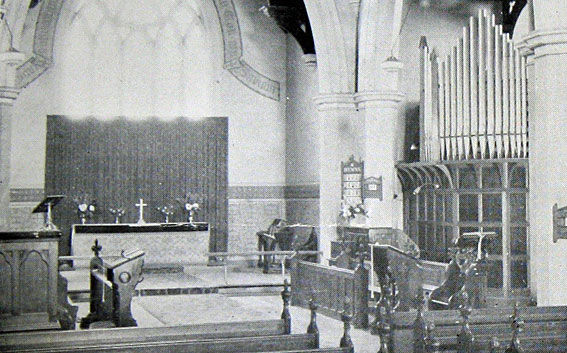
St Mary's Episcopal Church, North Melbourne
[Cover Photograph: St Mary's Church of England, North Melbourne:
Planned Giving Programme, April 1961.]
The final phase in the chequered history of this organ began in 1969, when the instrument was electrified with tonal additions by Myles Browne of Melbourne.21 By the time it was removed in 1982 to make way for the present organ, it was only partially playable.22
Present Organ.
The present organ was built in 1958 by Werner Bosch of Sandershausen (near Kassel), West Germany, for the Elizabeth Street Brethren Chapel, Wellington, New Zealand, where it was installed by Croft & Son of Auckland. The purchase of the instrument had been arranged through a member of the congregation who had business contacts in Germany.23
The Elizabeth-Street Chapel was closed, and has since been converted into apartments.24 Early in 1974, the organ was advertised for sale,25 and it was installed in mid 1975 in the Methodist Church, Toowong, Queensland, by Walter Emerson of Toowoomba.26
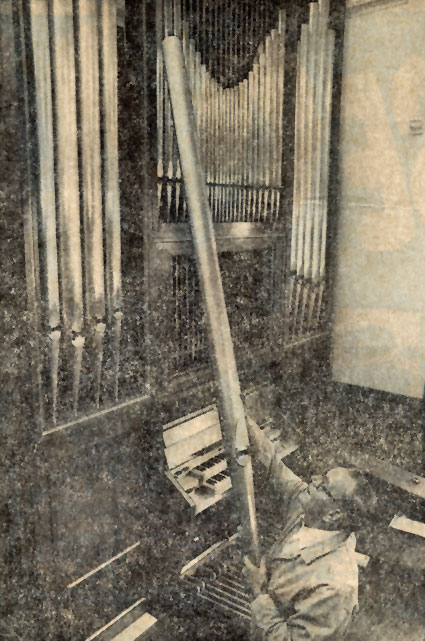
Walter Emerson installing the Werner Bosch organ at Toowong in 1975
[Photograph: The Sunday Mail (8 June 1975), p. 18]
Purchased at the instigation of Graeme Morton, then organist of the Toowong church, the instrument was significant at the time as the first modern tracker-action neo-baroque organ in Brisbane. The specification was as follows:
| HAUPTWERK Bourdon Principal Gemshorn Mixture BRUSTWERK Flute Flute Principal Quint Cymbel Krumhorn PEDAL Sub Bass Open Flute COUPLERS Bw-Hw Hw-Ped Bw-Ped |
8 4 2 IV (enclosed) 8 4 2 1-1/3 II 8 16 8 |
Mechanical action.27
There had been an attempt in New Zealand to add Swell shutters to the Brustwerk, but these were not installed at Toowong.28 A factory-produced instrument of early Orgelbewegung design, it was neither tonally nor mechanically distinguished.
When the Toowong Uniting Church was closed, the organ was again advertised for sale, and it was purchased for $15,000 by the present church. Knud Smenge was sent to Brisbane to assess the instrument, and presented proposals for tonal and mechanical improvement.
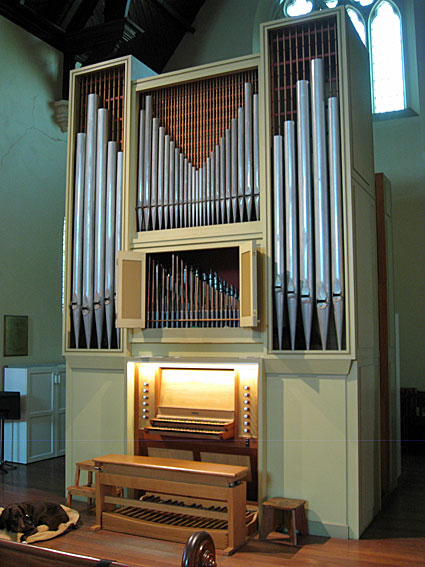
The Werner Bosch organ, rebuilt by Knud Smenge at North Melbourne
[Photograph by Geoffrey Cox (March 2017)]
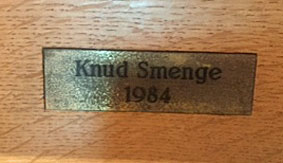
Knud Smenge's nameplate
[Photograph by Beverley Phillips (March 2017)]
Knud Smenge had arrived in Australia in January 1979 to work with George Fincham & Sons in Melbourne, but remained with Finchams for only two years before founding his own firm in January 1981. The contract to rebuild the Werner Bosch organ at St Mary's was his first major contract in Melbourne, although he had already completed a two-manual organ for St Peter's Lutheran Church, Beenleigh, Queensland in 1983.29 Both were typical of Smenge's work in their adherence to the principles of the Orgelbewegung, reflecting his training and experience with the Danish firms of Marcussen and Christensen in the 1960s and 1970s.
In rebuilding the organ for North Melbourne, Smenge was constrained by the general layout of the instrument and the scaling of the pipework. All of the original pipework was retained in the rebuilt instrument, although it was re-voiced and the stops were re-named. Cone tuning was retained, and a tremulant was added to the Brustwerk. The pedal pipes, originally located in the two pedal towers, were re-located to a new case at the rear of the instrument, and the entire case was painted by David Agg (organist of St Mary's, 1980-1984). The console was redesigned and rebuilt in oak and mahogany, with redgum drawstops and a new oak bench. The Brustwerk was provided with doors, and new pipe shades were fitted to the Hauptwerk and Pedal towers. A new floating mechanical action was made, as well as new stop action.30
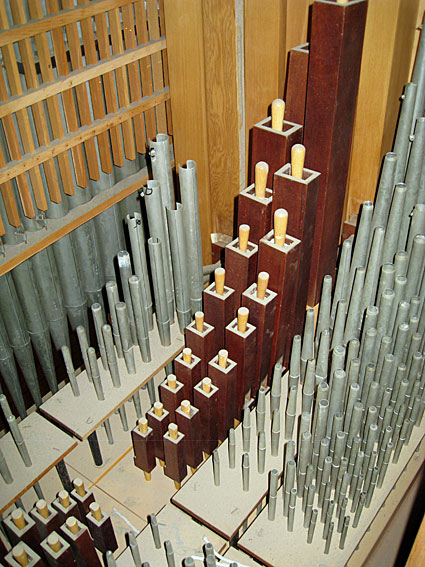
Pipework of the Hauptwerk
[Photograph by Geoffrey Cox (March 2017)]
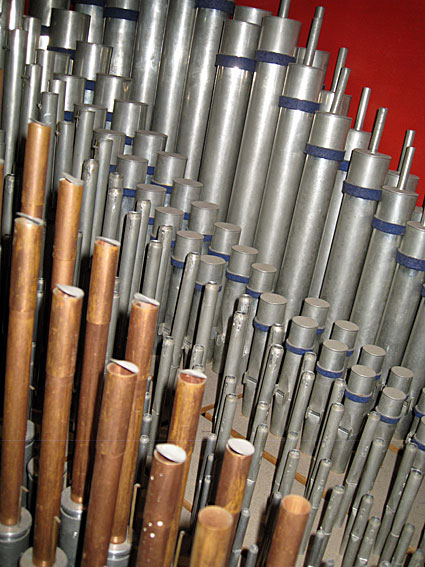
Pipework of the Brustwerk
[Photograph by Geoffrey Cox (March 2017)]
The rebuilt organ was dedicated on the 25 March 1984 by Bishop James Grant, and opened with a recital by David Agg on 1 April, with recitals by Douglas Lawrence and John O'Donnell in the week following. The entire cost of rebuilding the instrument had been raised by special efforts and donations by the time of the opening.31
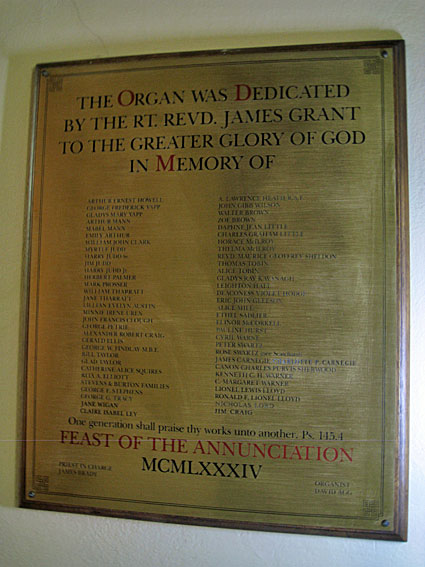
The Donors' Plaque
[Photograph by Geoffrey Cox (March 2017)]
HAUPTWERK |
8 4 2 IV 8 4 2 1-1/3 II 8 16 8 |
Tremulant
Mechanical action
Pedalboard: straight and concave
Compass: 56/30.32
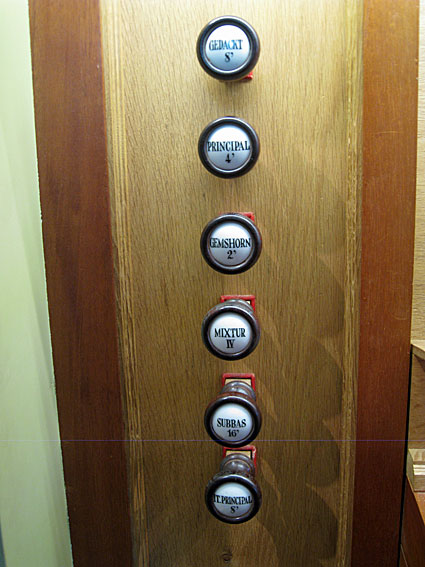
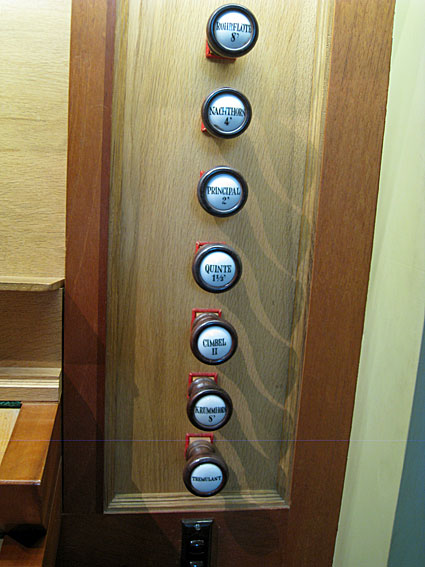
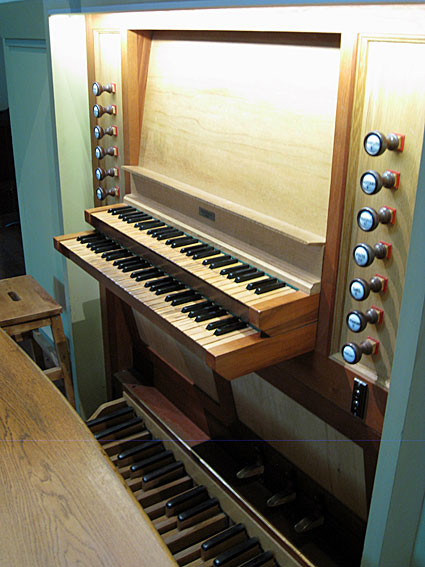
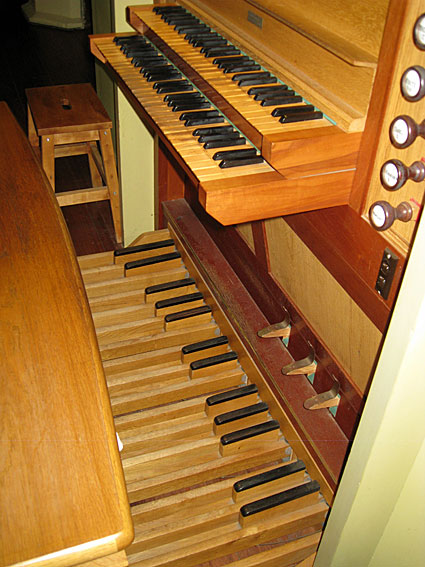
Stop jambs and console details
[Photographs by Geoffrey Cox (March 2017)]
______________________
1 The Age (26 October 1858), p. 6.
2 The Argus (14 March 1860), p. 4.
3 Miles Lewis (ed.), Victorian Churches (Melbourne: National Trust of Australia (Victoria), 1991), p. 55.
4 The Argus (31 August 1868), p. 6; The Illustrated Australian News (1 December 1868), p. 4.
5 'Details of St Mary's Organ Fund' in Churchwarden's Report for 1879. George Frederick Stephens, 'Papers 1853-1945,' State Library of Victoria, MS 7132 (Box 1791/9).
6 The Argus (12 September 1879), p. 4.
7 The Age (13 September 1879), p. 5.
8 'Specification of Organ in St Mary's Church of England, Hotham (North Melbourne) built by Mr William L. Anderson 1879' in Stephens, 'Papers,' op. cit. (Box 1791/10; hand-written version of the specification in Box 1791/11, and letters from Hayward to Stephens in Boxes 1791/7 and 1791/10).
9 Churchwarden's Annual Report for 1879, in Stephens, 'Papers,' op. cit. (Box 1791/9).
10 'Abstract of Receipts and Expenditure' in Churchwarden's Report for 1880, in Stephens, 'Papers,' op. cit. (Box 1791/9).
11 George Fincham Letters 14/456 and 9/203, cited in E.N. Matthews, Colonial Organs and Organbuilders (Carlton: Melbourne University Press, 1969), p. 141.
12 George Fincham Letters 22/618, op. cit.; 'Vestry Report' in St Mary's Church of England, North Melbourne: Jubilee Souvenir, 1860-1910, p. 3, cited in Stephens, 'Papers,' op. cit. (Box 1791/1).
13 Letter from George Fincham & Sons Pty Ltd to G. Stephens, dated 31 July 1929, in Stephens, 'Papers,' op. cit. (Box 1791/10).
14 Correspondence and estimates in Stephens, 'Papers,' op. cit. (Box 1791/11).
15 'Contract of Work to be Carried Out by Messrs Roberts Ltd, Adelaide,' in Stephens, 'Papers,' op. cit. (Box 1791/11).
16 'Specification of Organ, St Mary's Church of England, North Melbourne,' in Stephens, 'Papers,' op. cit. (Box 1791/7).
17 The Parish Messenger: in connection with St Mary's Church of England, North Melbourne, vol. xxi, nos. 8-11 (August-November 1930), cited in Stephens, 'Papers,' op. cit. (Box 1791/7 and 1791/10). Original recital programs in Box 1791/11.
18 Letter from Norman Hansen to the Friends of St Mary's, dated 19 February 1945, in Stephens, 'Papers,' op. cit. (Box 1791/11).
19 St Mary's Church Parish Paper North Melbourne, February-December 1945, in Stephens, 'Papers,' op. cit. (Box 1791/2).
20 St Mary's Church of England, North Melbourne: Planned Giving Programme, April 1961, in Stephens, 'Papers,' op. cit. (Box 1791/10).
21 John Maidment, Gazetteer of Victorian Pipe Organs (updated May 2015), cited February 2017 at: http://www.ohta.org.au/gaz/vicgaz.htm
22 Personal communication from David Agg to G. Cox, March 2017.
23 Ron Mackay, 'The Werner Bosch Organ at St Mary's Anglican Church, North Melbourne,' Organ News [The New Zealand Association of Organists], vol. 34, no. 3 (November 1998), pp. 63-65.
24 Personal correspondence from Peter Russell to Beverley Phillips (Organist of St Mary's), 12 October 2012.
25 The Sydney Organ Journal, vol. 5, no. l (January 1974), p. 3.
26 The Sunday Mail (8 June 1975), p. 18; Personal communication to G. Cox from Walter Emerson, 14 May 1975.
27 Specification supplied by Graeme Morton, August 1974.
28 Mackay, op. cit., pp. 63-64.
29 David Kinsela, 'The Organ at Newington College, Sydney,' Victorian Organ Journal (October 1985), pp. 3-12; John Maidment, 'List of Organs built by Knud Smenge Pty Ltd.' http://www.ohta.org.au/doc/Smenge.html - cited March 2017.
30 David Agg, 'The New Organ for St. Mary's Anglican Church, North Melbourne,' Victorian Organ Journal (February 1984), pp. 11-13.
31 Agg, op. cit., p. 12.
32 Specification noted by Geoffrey Cox, March 2017.